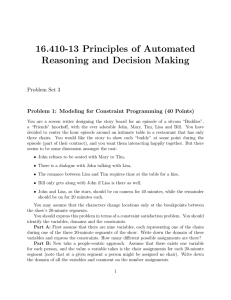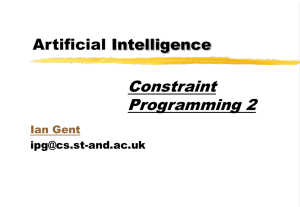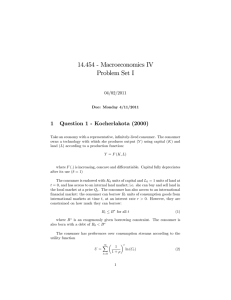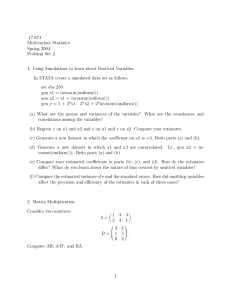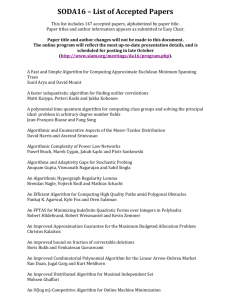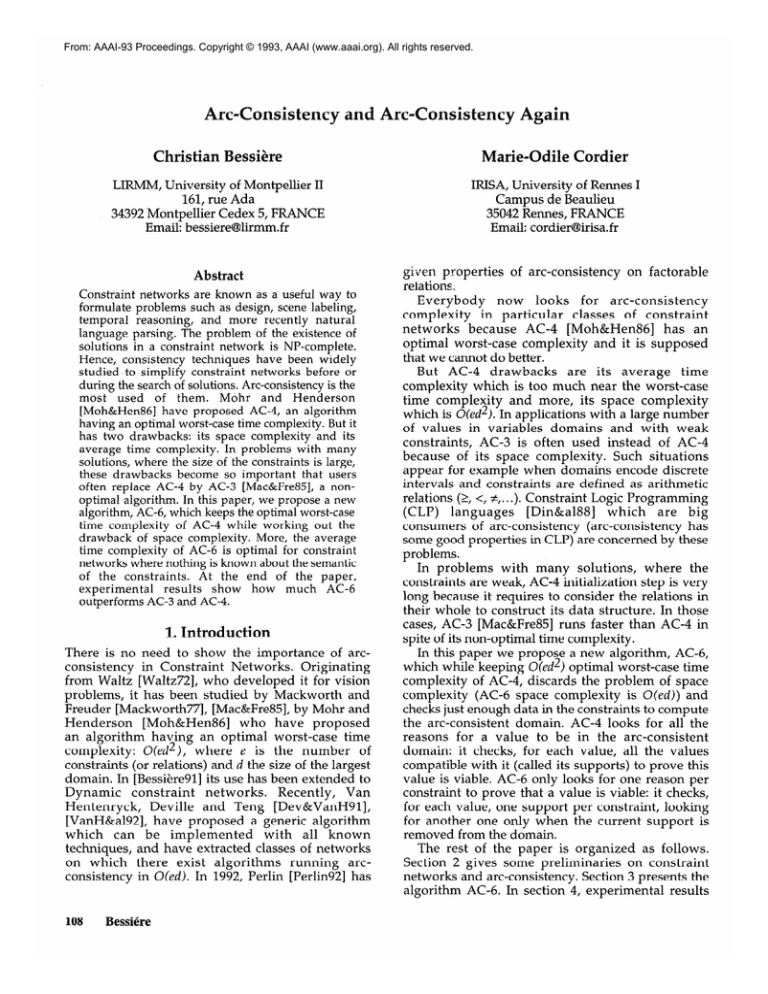
From: AAAI-93 Proceedings. Copyright © 1993, AAAI (www.aaai.org). All rights reserved.
Christian
Bessihe
LIRMM,
Cordier
University of Montpellier II
161, rue Ada
34392 Montpellier Cedex 5, FRANCE
Email: bessiere@lirmm.fr
IRISA, University of Rennes I
Campus de Beaulieu
35042 Rennes, FRANCE
Email: cordier@irisa.fr
Abstract
g” ven properties
of arc-consistency
on factorable
relations.
Everybody
now looks
for arc-consistency
complexity
in particular
classes of constraint
networks
because AC-4 [Moh&Hen86]
has an
optimal worst-case complexity
and it is supposed
that we cannot do better.
But AC-4 drawbacks
are its average
time
complexity which is too much near the worst-case
time complexity
and more, its space complexity
which is O(ed2). In applications with a large number
of values in variables domains and with weak
constraints,
AC-3 is often used instead of AC-4
because of its space complexity.
Such situations
appear for example when domains encode discrete
intervals and constraints are defined as arithmetic
relations (2, <, f,... ). Constraint Logic Programming
(CLP) languages
[Din&a1881
which
are big
consumers of arc-consistency
(arc-consistency
has
some good properties in CLP) are concerned by these
problems.
In problems
with many solutions,
where the
constraints are weak, AC-4 initialization
step is very
long because it requires to consider the relations in
their whole to construct its data structure. In those
cases, AC-3 [Mac&Fre85]
runs faster than AC-4 in
spite of its non-optimal time complexity.
In this paper we propose a new algorithm, AC-6,
which while keeping O(ed2) optimal worst-case time
complexity of AC-4, discards the problem of space
complexity
(AC-6 space complexity
is O(ed)) and
checks just enough data in the constraints to compute
the arc-consistent
domain. AC-4 looks for all the
reasons for a value to be in the arc-consistent
domain: it checks, for each value, all the values
compatible with it (called its supports) to prove this
value is viable. AC-6 only looks for one reason per
constraint to prove that a value is viable: it checks,
for each value, one support per constraint, looking
for another one only when the current support is
removed from the domain.
The rest of the paper is organized
as follows.
Section 2 gives some preliminaries
on constraint
networks and arc-consistency. Section 3 presents the
algorithm AC-6. In section 4, experimental
results
Constraint networks are known as a useful way to
formulate
problems
such as design, scene labeling,
temporal
reasoning,
and more recently
natural
language parsing. The problem
of the existence of
solutions
in a constraint
network
is NP-complete.
Hence, consistency
techniques
have been widely
studied to simplify
constraint
networks
before or
during the search of solutions. Arc-consistency
is the
most
used
of them.
Mohr
and Henderson
[Moh&Hen86]
have proposed
AC-4, an algorithm
having an optimal worst-case time complexity.
But it
has two drawbacks:
its space complexity
and its
average time complexity.
In problems
with many
solutions, where the size of the constraints is large,
these drawbacks
become so important
that users
often replace AC-4 by AC-3 [Mac&Fre85],
a nonoptimal algorithm.
In this paper, we propose a new
algorithm,
AC-6, which keeps the optimal worst-case
time complexity
of AC-4 while working
out the
drawback
of space complexity.
More, the average
time complexity
of AC-6 is optimal
for constraint
networks where nothing is known about the semantic
of the constraints.
At the end of the paper,
experimental
results
show
how
much
AC-6
outperforms
AC-3 and AC-4.
1. Introduction
There is no need to show the importance
of arcconsistency in Constraint
Networks.
Originating
from Waltz [Waltz72], who developed it for vision
problems, it has been studied by Mackworth
and
Freuder [Mackworth77],
[Mac&Fre85], by Mohr and
Henderson
[Moh&Hen86]
who have proposed
an algorithm
having an optimal worst-case time
complexity:
O(ed2 ), where e is the number
of
constraints (or relations) and d the size of the largest
domain. In [Bessiere91] its use has been extended to
Dynamic
constraint
networks.
Recently,
Van
Hentenryck,
Deville and Teng [Dev&VanH91],
[VanH&al92],
have proposed a generic algorithm
which
can be implemented
with
all known
techniques, and have extracted classes of networks
on which there exist algorithms
running
arcconsistency in O(ed). In 1992, Perlin [Perlin92] has
10s
Marie-Odile
BessiCre
show how much AC-6 outperforms
the algorithms
AC-3 and AC-4l. A conclusion is given in section 5.
A network of binary constraints (CN) is defined as a set
of n variables {i, j,. . .], a domain D=]Di, Dj,. . .I where
Di is the set of possible values for variable i, and a set
of binary constraints between variables. A binary
constraint (or relation) Xij between variables i and j is
a subset of the Cartesian
product
Di x D j that
specifies the allowed pairs of values for i and j.
Following from Montanari
[Montanari74],
a binary
relation Xi* between variables i and j is usually
represente d as a (O,l)-matrix (or a matrix of booleans)
with I Di I rows and I Dj I CO~UIIUISby imposing an
ordering on the domains of the variables. Value true
at row a, column b, denoted Rii<a, b), means that the
pair consisting of the ath element of Di and the bth
element of D * is permitted; value false means the pair
is not permi cted. In all the networks of interest here
Xij(a, b>=Rji(b, a). In some applications
(constraint
logic programming,
temporal reasoning,. . .), Rij is
defined as an arithmetic
relation (=, #, <, 2,. . .)
without
giving the matrix of allowed
and not
allowed pairs of values.
A graph G can be associated to a constraint
network, where nodes correspond to variables in the
CN and an edge links nodes i and j every time there
is a relation Rij on variables i and j in the CN. For the
purpose of this paper, we consider G as a symetric
directed graph with arcs (i, j) and (j, i) in place of the
edge {i, j}.
A solution of a constraint
network
is an
instantiation
of the variables
such that all the
constraints are satisfied.
Definition.
Having the constraint Xi*, value b in
Dj is called a support for value a in d i if the pair
(a, b) is allowed by Rij (i.e. Rij(a, b) is true).
A value a for a variable i IS viable if for every
variable j such that Rij exists, a has a support
in D*.
d e domain D of a CN is arc-consistent if for
every variable i in the CN, all the values in Di
are viable.
3. Arc-consistency
with
u
3.1. Preamble
As Mohr and Henderson
underlined
in [Moh&Hen86], arc-consistency
is based on the notion of
support. As long as a value a for a variable i (denoted
IAC-5
[VanH&al92]
is not
improvement
but a generic
algorithms
can be written.
discussed
framework
here since
in which
(i, a)) has supporting
values on each of the other
variables j linked to i in the constraint graph, a is
considered a viable value for i. But once there exists a
variable on which no remaining value satisfies the
relation with (i, a), then a must be eliminated
from Di.
The algorithm proposed in [Moh&Hen86]
makes
this support
explicit
by assigning
a counter
counter[(i, j), a] to each arc-value pair involving the
arc (i, j) and the value a on the variable i. This
counter records the number of supports of (i, a) in Dj.
For each value (j, b), a set S ‘b is constructed, where
sjb={(i, a)/(j, b) supports (i, aJ}. Then, if (j, b) is eliminated from Dj, counter[(i, j), a] must be decremented
for each (i, a) III Sjb.
This data structure is at the origin of AC-4 optimal
worst-case time complexity.
But computing
the
number of supports for each value (i, a) on each
constraint Rij and recording
all the values (i, a)
supported by each value Jj, b) implies an expensive
space complexity of O(ed-) (the size of the support
sets Sjb) and an average time complexity increasing
with the number of allowed pairs in the relations
since the number of supports is proportional
to the
number of allowed pairs in the relations.
The purpose
of AC-6 is then to avoid the
expensive checking of the relations to find all the
supports for all the values. AC-6 keeps the same
principle as AC-4, but instead of checking all the
supports for a value, it only checks one support (the
first one) for each value (i, a) on each constraint Ri* to
prove that (i, a) is currently viable. When (j, br’ is
found as the smallest support of (i, a) on Rij, (i, a) is
added to Sjb, the list of values currently having (j, b)
as smallest support. If (j, b) is removed from Dj then
AC-6 looks for the next support in Dj for each value
(i, a) in Sjb. The only requirement in the use of AC-6
is to have a total ordering in all domains Dj. But this
is not a restriction since in any implementation,
a
total ordering
is imposed on the domains.
This
ordering is independent
of any ordering computed
in a rearrangement strategy for searching solutions.
3.2. The algorithm
The algorithm
proposed
here works with the
following data structure:
e A table M of booleans keeps track of which
values of the initial domain are in the current domain
or not (M(i, a)=true H aE Di). In this table, each initial
Di is considered as the integer range I.. 1Di ] . But it
can be a set of values of any type with a total
ordering
on these values. We use the following
it is not an
all previous
Constraint-Based
Reasoning
109
constant time functions to handle Di sets that are
considered as lists:
-first(Q ) returns the smallest value in Q.
- last(Q ) returns the largest value in Q.
- next(u, Di ) returns the value a’ in Di such
that every value a D larger than a and smaller than a ’
is out of Di.
0 Sjb=I(i, a>/& b) is the smallest value in D j
supporting
(i, a) on Xii) while in AC-4 it was
containing all the values supported by (j, b).
0 Counters for each arc-value pair in AC-4 are not
used in AC-6.
e A list List contains values deleted from the
domain but for which the propagation of the deletion
has not been processed yet.
In AC-4, when a value (j, b) was deleted, it was
added to List waiting for the propagation
of the
consequences of its deletion. These consequences
were to decrement counfer[(i, j), a] for every (i, a) in
Sjb and to delete (i, a) when counfer[(i, j), a] becomes
equal to zero. In AC-6, the use of List is not changed
but the consequence of (j, 6) deletion is now to find
another support for every (i, a) in S-b. Having an
ordering on Dj we look after b (the o I!d support) for
another value c in Dj supporting
(i, a) on Xij (we
know there is no such value before b). When such a
value c is found, (i, a) is added to Sjc since (j, c) is the
new smallest support for (i, a) in Dj. If no such value
exists, (i, a) is removed and put in List.
AC-6 uses the following
procedure to find the
smallest value in Dj not smaller
than b and
supporting (i, a) on Rij:
procedure
nextsupport(in
{search of the smallest
while not R$a, b) and
if b c last(Dj) then
else emptysupport
support for (i, a) in Dj}
not emptysuppoftdo
b t next(b, Dj)
t true
end;
The algorithm AC-6 has the same framework
as
AC-4. In the initialization
step, we look for a support
for every value (i, a) on each constraint Rq to prove
that (i, a) is viable. If there exists a constraint Rij on
which (i, a) has no support, it is removed from Di
and put in List.
In the propagation
step, values (j, b) are taken
from List to propagate
the consequences of their
deletion: finding another support (j, c) for values (i, a)
BessiCre
{initialization}
for(i, a) E Ddo &t0;
M(i, a)+ true;
for ((1) E arcs(GJ do
foraE
Did0
begin
if Dj= 0
then emptysupport
t true
else
b t first(Dj) ;
nextsupport(i, j, a, b, emptysupport
if emptysuppott
then
Di t Di\ {a} ; M(i, a) t false ;
Append( List, (i, a))
else Append(Sjb,
(i, a))
end
);
{propagation}
while List # 0 do
begin
choose (j, b) from List and remove (j, b) from List;
for (i, a) E sjb do
{before its deletion (j, b) was the
begin
smallest support in Djfor (i, a) on Rii}
remove (i, a) from sjb ;
if M(i, a) then
begin
c t b ; nextsupport(i, j, a, c, emptysupport)
;
if emptysupport
then Di t Di\ {a} ; M(i, a) t false ;
Append( List, (i, a))
i:;
Append(Sjc,
(i, a))
i, j, a : integer; in out b : integer;
out emptysupport
: boolean);
begin
{search of the smallest value as large as b that
belongs to Dj; this part is not needed in the call of
the procedure
done in the initialization
step since b
already belongs to Dj }
while not M(j, b) and b c last(Dj ) do b t b + 1 ;
emptysupport
t not M(j, b) ;
110
they were supporting (values (i, a) in Sjb). When such
a value c in Di is not found, (i, a) is removed from Di
and put in Lid at its turn.
end
end
3.3. Correctness
of AC-6
Here are the key steps for a complete proof of the
correcmess of AC-6. In this section we denote maxAC
the maximal arc-consistent domain which is expected
to be computed by an arc-consistency algorithm.
0 In AC-6, value (i, a) is removed from Di only
when it has no support in Dj on a constraint Ri*. If all
previously removed values are out of maxA 6 then
(i, a) is out of maxAC. maxAC was trivially included
in D when AC-6 started. Then, by induction, (i, a) is
out of maxAC. Thus, maxAC CD is an invariant
property of AC-6.
* Every time a value 0, b) is removed, it is put in
List until the values it was supporting
are checked
for new supports. Every time a value (i, a) is found
without support on a constraint, it is removed from
D. Thus, every value (i, a) in D has at least one
support in DuLisf
on each constraint
Rij. AC-6
terminates with List empty. Hence, after AC-6, every
orresponding
to a house position (e.g. assigning the
value 2 to the variable horse means that the horse
owner lives in the second house) [Dechter88].
eferences
Bessiere, C. 1991. “Arc-Consistency
in Dynamic
Constraint Satisfaction Problems”; Proceedings 9th
National
Conference
on Artificial
Intelligence,
Anaheim CA, 221-226
Dechter, R. 1988. “Constraint Processing Incorporating
Backjumping, Learning, and C&set-Decomposition”;
Proceedings
4th IEEE Conference
on AI for
Applications, San Diego CA, 312-319
Deville, Y. and Van Hentenryck, I?. 1991. “An Efficient
Arc Consistency Algorithm for a Class of CSP
Problems”; Proceedings 12th International
Joint
Conference
on Artificial
Intelligence,
Sydney,
Australia, 325-330
Dincbas, M., Van Hentenryck,
P., Simonis, H.,
Aggoun, A., Graf, T. and Berthier, F. 1988. “The
constraint
logic programming
language CHIP”;
Proceedings
International
Conference
on Fifth
Generation Computer Systems, Tokyo, Japan
Janssen, P., Jegou, P., Nouguier,
B., Vilarem, M.C.
and Castro, B. 1990. “SYNTWA: Assisted Design of
Pep tide Synthesis Plans”; New Journal of Chemistry,
14-12,969-976
Mackworth,
A.K. 1977. “Consistency in Networks of
Relations”; Artificial Intelligence 8,99-118
Mackworth,
A.K. and Freuder,
E.C. 1985. “The
Complexity of Some Polynomial Network Consistency
Algorithms for Constraint Satisfaction Problems”;
Artificial Intelligence 25, 65-74
Mohr, R. and Henderson, T.C. 1986. “Arc and Path
Consistency Revisited” ; Artificial
Intelligence
28,
225-233
Montanari,
U. 1974. “Networks of Constraints:
Fundamental Properties and Applications to Picture
Processing”; Information Science 7,95-132
Perlin, M. 1992. “Arc-consistency
for factorable
relations”; Artificial Intelligence 53, 329-342
Van Hentenryck, I’., Deville, Y. and Teng, CM. 1992.
“A generic arc-consistency
algorithm
and its
specializations”; Artificial Intelligence 57,291-321
Waltz, D.L. 1972. “Understanding
Line Drawings of
Scenes with Shadows”; in: The Psychology
of
Computer Vision, McGraw Hill, 1975, 19-91 (first
published in: Tech.Rep. A1271, MIT MA, 1972)
Constraint-Based
Reasoning
113

